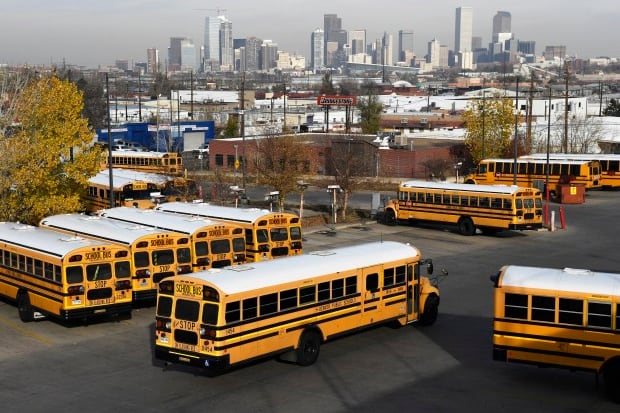Two new proposals for how to redraw Denver’s school board boundaries have drawn fire from community groups for the effect they could have on Latino voting power.
“These two proposals look to us like deliberate gerrymandering,” said Milo Marquez, a Denver Public Schools parent and member of the Latino Education Coalition. “I think it’s going to diminish the voting power of Latinos in District 2.”
District 2 encompasses southwest Denver, which is home to many Latino residents. A Latina board member, President Xóchitl “Sochi” Gaytán, currently represents the district. But based on its population, District 2 is too small. By law, each board member must represent roughly the same number of residents. Right now, the balance is off.
To fix that, Denver Public Schools must redraw board member boundaries to enlarge District 2 in southwest Denver and shrink District 4 in northeast Denver, which is too big.
Redistricting won’t affect school boundaries or where students go to school. It’s about which neighborhoods school board members represent.
The school district has been holding community meetings about redistricting since Jan. 31, but officials said attendance has been low. The final two meetings are scheduled for Wednesday. The school board is set to choose new boundaries next month. The new map is supposed to be in effect for the upcoming school board election in November.
The school district originally proposed four maps — Scenarios A, B, C, and D — that would expand District 2 by adding neighborhoods to the north from what is now District 5. The scenarios would slightly alter the racial makeup of District 2.
The two most drastic proposals would decrease the percentage of Latino residents in District 2 by 3.25% and increase the percentage of white residents by 2.3%, according to district data.
Earlier this month, school district staff added two other alternatives, Scenarios E and F, with bigger demographic shifts. These two scenarios would expand District 2 by adding neighborhoods to the east from what is now heavily white District 1.
Scenario E, for example, would decrease the percentage of Latino residents in District 2 by 6.5% and increase the percentage of white residents by 6.8%.
Liz Mendez, executive director of enrollment and campus planning for DPS, called the potential shift in demographics a real concern.
“The other concern is how people vote,” she said. If the white residents in District 1 are more likely to vote in low-turnout school board elections, Mendez said, “then is the voice of the folks who lived in District 2 going to become overshadowed by the new group of people, and will that change who is elected as the representative in that district?”
Mendez said Scenarios E and F were added because community members who attended one of the district’s meetings asked for more options, especially some that would change the boundaries of District 1, which was untouched in Scenarios A, B, C, and D. The district got similar feedback through an online survey, Mendez said.
Scenarios E and F would pose a problem for the board member who currently represents District 1, Scott Baldermann. Under both scenarios, Baldermann’s home address would move into District 2, making him ineligible for re-election in District 1. Baldermann was first elected to the board in 2019 and his seat is up for grabs in November.
He declined to comment for this story.
Another board member, Charmaine Lindsay, would also be affected by the redistricting scenarios. In five of the six scenarios, her home address would move into District 2.
Lindsay was appointed last year to represent District 5 after former board member Brad Laurvick resigned because he moved out of Denver for his job. Lindsay said at the time that she wasn’t interested in running for the seat in November. She said last week that she is “OK with District 5 moving” and would cast her vote based on community feedback.
Current board members’ home addresses weren’t a factor the district considered when making the maps, Mendez said — an approach several community groups said they agree with. But those groups have other concerns about the overall process and even with the initial scenarios proposed by district staff.
Clarence Burton Jr., CEO of Denver Families for Public Schools, an advocacy group that works on voter participation, said he’s concerned that two of the original four maps would move some historically Black neighborhoods like Five Points and Whittier from District 4, which often has elected a Black school board representative, into District 5, which hasn’t.
While the demographics of Five Points and Whittier have changed a lot in recent decades, Burton said their historical significance should still be considered.
His group is also concerned that some of the scenarios would concentrate elementary schools with declining enrollment that are at risk for closure into District 2, putting the bulk of the burden of advocating for those schools onto a single school board member.
But by far the most common concern about the redistricting proposals has been about the process. Every community group Chalkbeat spoke to said the process has felt rushed and inauthentic, which are familiar complaints about the way the district gathers feedback.
“It’s another one of those, ‘DPS just did it and you’re asking us for our opinion,’” said Tiffany Grays, a district parent and chair of the Black Family Advisory Council. “We should have been at the table when you were creating the maps.”
Melanie Asmar is a senior reporter for Chalkbeat Colorado, covering Denver Public Schools. Contact Melanie at masmar@chalkbeat.org.








